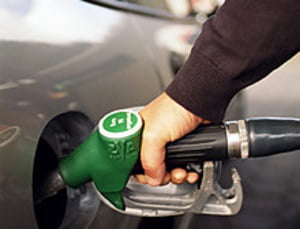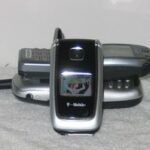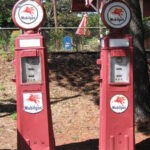Each year, Americans pump fuel into cars around 11 – 12 BILLION times, according to a report by the Petroleum Equipment Institute (PEI). Despite laws requiring retailers to install safety nozzles, post warning signs, sell only approved fuel containers, clean fuel spills, and properly dispose of unwanted fuel, around 100 accidents still occur each year, according to some industry insiders.
There are reports that suggest the use of cell phones can cause gas pump fires, although the PEI has received no reports linking cell phone use to gas pump fires. The odds of 100 in 12 billion may not be high, but following some simple gas pump safety tips may save you from serious injury.
When I owned a store with gas pumps, it was alarming to observe the dozens of people each year that disregarded safety precautions at the gas pumps. We had to respond to people who approached the gas pumps with lit cigarettes, drove off with the nozzle still in the car, allowed children to pump gas, pumped gas with restrained infants in the car, pumped gas while sitting in their car, and pumped gas into a container on the bed of a truck or flatbed trailer. You can avoid a serious accident by following the gas pump safety tips below.
Also alarming, were the number of people who do not know that a GREEN or YELLOW pump and nozzle means the fuel is DIESEL. One of our customers accidentally filled her lawn mower gas container with diesel fuel and began pouring it out into our flowerbed. Others used our hose to rinse out onto our lawn, kerosene, paint thinner or diesel from old containers before filling them with gasoline.
Some customers topped off their tank and left gasoline spilled near the pumps without informing a clerk of the spill. Serious gas pump accidents can be avoided by not leaving spilled or unwanted fuel by the gas pumps. (not to mention the environmental damage from fuel spills)
How Do Gas Pump Fires Happen? (click here to view video)
50% happen when the person returns to the vehicle during refueling and leaves the vehicle door open
29% happen when the person unscrews the gas cap
21% happen for unknown reasons – theories include new chemical used in tires, more electronics in cars, seat fabrics, and more volatile fuels
78% are women who return to the car to put a credit card into their purse, get money, write a check, get warm, check on the kids, write down odometer reading, apply lipstick, or use cell phone
Pulling the nozzle out of the car after a fire ignites
Gas Pump Safety Tips
ALWAYS TURN OFF YOUR CAR
Some theories suggest that more electronics in cars contribute to gas pump accidents.
ALWAYS TOUCH METAL WHENEVER YOU EXIT YOUR CAR
Static electricity causes most of the sparks that ignite gas pump fires. Touching metal will discharge static electricity.
NEVER SMOKE, LIGHT A MATCH, OR USE LIGHTERS WHEN REFUELING
It is not just the fuel liquid that is flammable. Fumes are also highly flammable.
STAY CLOSE TO THE FUEL AREA. NEVER RETURN TO YOUR CAR WHILE FUELING
Some states now require you to hold the nozzle while pumping instead of locking the nozzle to auto-fuel.
NEVER LET YOUR CHILDREN PUMP GAS AND DO NOT LEAVE RESTRAINED INFANTS IN THE VEHICLE
If your children pump gas, they should be educated on the safety tips. If there is a fire, it is easier to get an unrestrained infant out of the vehicle.
DO NOT TOP OFF YOUR TANK; ONLY FILL FUEL CONTAINERS 95% FULL
Gasoline needs room to expand. Filling anything full of fuel can increase chances of accidents from fumes.
ALWAYS PLACE A FUEL CONTAINER ON THE GROUND BEFORE FUELING
Never leave a container in the trunk of a car, in the bed of a truck, or on a flatbed of a trailer. Only use approved fuel storage containers.
LEAVE THE NOZZLE IN THE CAR IF A SPARK IGNITES THE FUEL; ASK ATTENDENT TO CUT OFF GAS WITH EMERGENCY SWITCH
Some of the major injuries and damage from gas pump fires occurred when people instinctively removed the nozzle from the vehicle after a fire started. A flaming nozzle can further ignite fumes in the air, fuel spills on clothes and people, and fuel spills on the ground. Keep the nozzle in contact with the container.
NEVER REFUEL A HOT LAWN MOWER, 4-WHEELER, GO-CART, CHAIN SAW, WEED EATER, OR OTHER GAS POWERED EQUIPMENT
NEVER MIX GASOLINE WITH KEROSENE OR DIESEL. USE NEW OR SEPARATE APPROVED CONTAINERS
Please use these gas pump safety tips and hopefully the following accidents will not happen to you:
Las Vegas, Nevada – a fire broke out at the gas pump as Alexis Camfora, age 11, pumped gas while her mother paid inside. Alexis had 21 operations during her four-month hospital stay. Alexis pulled the flaming nozzle out of the car which caused a larger fire that burned her body from the neck down.
Spring, Oklahoma – Ann Gouker was killed by a large fire that broke out at the gas pump. Ann was a 33-year old mother of four children. Ann pulled the flaming nozzle from the car which caused a larger fire from fumes and gas pouring from the nozzle.
Waynesville, North Carolina – a 12-year-old girl was seriously burned when she removed the nozzle after sitting in the car, while her mother sat in the car and wrote a check for the gas.
Spartanburg, South Carolina – Ignacio Sierra experienced a gas pump fire that ignited as his 4-year-old daughter was buckled up inside his truck. Both survived, but his truck and a part of the gas station were destroyed.
San Antonio, Texas – Robert Clewes, a 58-year-old retired Air Force officer, received severe burns over 17% of his body after a fire broke out at a gas pump.
Sources:
http://www.cfs.purdue.edu/extension/ppt/gaspump-slides.ppt
http://archives.cnn.com/2002/US/12/05/gas.pump.fires/index.html
http://www.cbsnews.com/stories/2004/08/27/earlyshow/living/ConsumerWatch/main638947.shtml
http://consumeraffairs.com/news02/gas_fires.html
http://www.local6.com/news/1835430/detail.html






